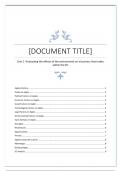Essay
2024 BTEC Business Level 3: Unit 1 - Exploring Business (Assignment 2) (Distinction)
- Course
- Institution
BTEC Business Level 3: Assignment 2 - Unit 1: Exploring Business. This is a Distinction-level assignment, featuring well-organised content with relevant images and excellent formatting. By using this exemplar template, you’ll have a strong guide to help you achieve high marks. The template co...
[Show more]



